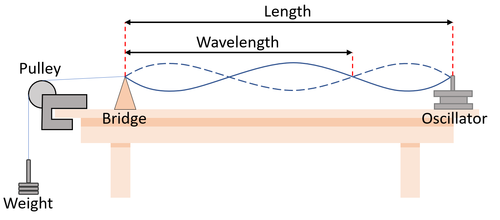Difference between revisions of "Waves on a String"
| Line 14: | Line 14: | ||
| style="height:20px; width:200px; text-align:center;" |'''Waves on a string''' can be observed using the [[equipment]] shown in the [[diagram]]. If the [[oscillator]] is set to a known [[frequency]] the [[wavelength]] can be measured with a ruler and this can be used to find the [[Wave Speed|wave speed]]. | | style="height:20px; width:200px; text-align:center;" |'''Waves on a string''' can be observed using the [[equipment]] shown in the [[diagram]]. If the [[oscillator]] is set to a known [[frequency]] the [[wavelength]] can be measured with a ruler and this can be used to find the [[Wave Speed|wave speed]]. | ||
|} | |} | ||
| + | |||
| + | ==Beyond the Curriculum== | ||
| + | {{#ev:youtube|https://www.youtube.com/watch?v=w6EGyFAGpXU}} | ||
Latest revision as of 16:30, 20 April 2019
Key Stage 4
Meaning
A wave on a string is a transverse wave that passes along a length of string, wire or cable.
About Waves on a String
- A wave on a string is a mechanical wave.
- A wave on a string is transverse because the oscillation is perpendicular to the direction of travel of the wave.
- Waves on a string, like all waves, carry energy and information but they do not transfer mass from one location to another.
| Waves on a string can be observed using the equipment shown in the diagram. If the oscillator is set to a known frequency the wavelength can be measured with a ruler and this can be used to find the wave speed. |
